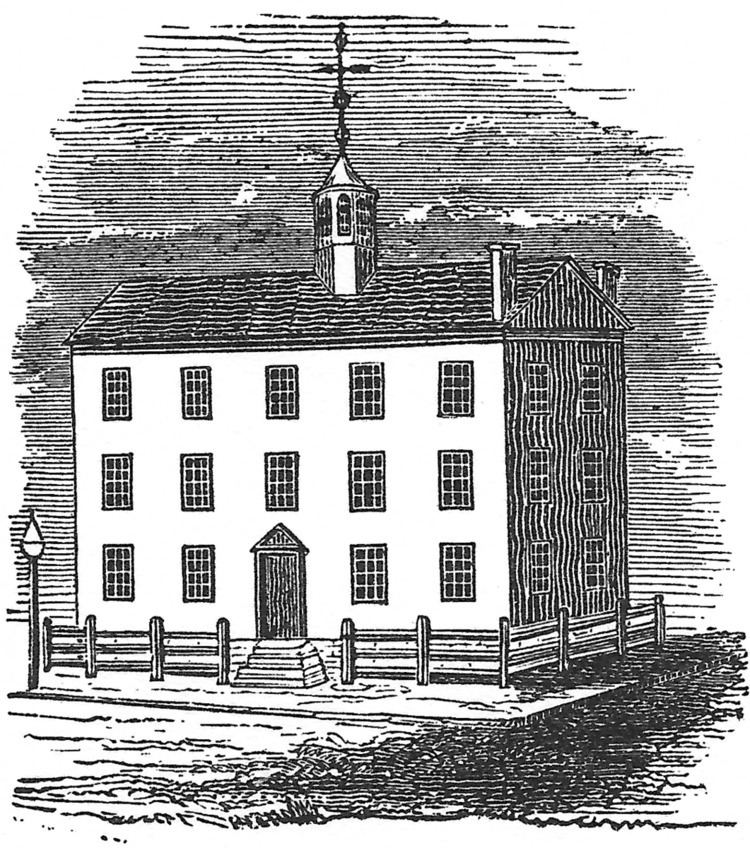Members 43 Members 108 | Party control Federalist (25-18) | |
 | ||
Term July 1, 1800 – June 30, 1801 President Lt. Gov. Stephen Van Rensselaer (Fed.) | ||
The 24th New York State Legislature, consisting of the New York State Senate and the New York State Assembly, met from November 4, 1800, to April 8, 1801, during the sixth year of John Jay's governorship, in Albany.
Contents
Background
Under the provisions of the New York Constitution of 1777, amended by the re-apportionment of March 4, 1796, Senators were elected on general tickets in the senatorial districts for four-year terms. They were divided into four classes, and every year about one fourth of the Senate seats came up for election. Assemblymen were elected countywide on general tickets to a one-year term, the whole assembly being renewed annually.
In 1797, Albany was declared the State capital, and all subsequent Legislatures have been meeting there ever since. In 1799, the Legislature enacted that future Legislatures meet on the last Tuesday of January of each year unless called earlier by the governor.
Senator John Addison died in 1800, leaving a vacancy in the Middle District.
In 1800, Greene County was created from parts of Albany and Ulster counties, and was apportioned 2 seats in the Assembly, one each taken from Albany and Ulster.
In August 1800, U.S. Senator John Laurance (Fed.) resigned.
At this time the politicians were divided into two opposing political parties: the Federalists and the Democratic-Republicans.
Elections
The State election was held from April 29 to May 1, 1800. Senators William Denning (Southern D.), James Gordon (Eastern D.) and Jedediah Sanger (Western D.) were re-elected. Benjamin Huntting, Ebenezer Purdy (both Southern D.), James W. Wilkin, David Van Ness, Solomon Sutherland, John C. Hogeboom (all four Middle D.), Stephen Lush (Eastern D.) and Assemblyman Robert Roseboom (Western D.) were also elected to full terms in the Senate. Jacobus S. Bruyn (Middle D.) was elected to a one-year term to fill the vacancy. Gordon, Sanger and Lush were Federalists, the other nine were Democratic-Republicans.
Sessions
The Legislature met at the Old City Hall in Albany on November 4, 1800, to elect presidential electors; and the Senate adjourned on November 7, the Assembly on November 8.
Dem.-Rep. Samuel Osgood was elected Speaker with 62 votes against 31 for Federalist Dirck Ten Broeck.
On November 6, 1800, the Legislature elected 12 presidential electors, all Democratic-Republicans: William Floyd, Isaac Ledyard, Anthony Lispenard, Philip Van Cortlandt Jr., James Burt, Gilbert Livingston, Thomas Jenkins, Peter Van Ness, Robert Ellis, John Woodworth, Jeremiah Van Rensselaer and Jacob Eaker. They cast their votes for Thomas Jefferson and Aaron Burr.
On November 6, 1800, the Legislature elected John Armstrong (Dem.-Rep.) to fill the vacancy in the U.S. Senate.
The Legislature met for the regular session on January 27, 1801; and adjourned on April 8.
On January 27, 1801, John Armstrong was re-elected to a full term in the U.S. Senate.
On February 26, 1801, Gov. John Jay sent a message to the Assembly about the controversy that had arisen in the Council of Appointment concerning the right to nominate appointees. Jay held that only the governor could nominate somebody, and the councillors then could only approve or reject this nomination. The Dem.-Rep. councillors however claimed that they too had the right to nominate appointees, and Jay had adjourned the Council and did not make any appointments anymore. Jay asked the Assembly to solve the problem, but they refused, claiming that it was a constitutional issue to be decided by the Governor and Council. Jay asked then the chancellor and the justices of the New York Supreme Court for their opinion, but they refused to give it, claiming that to give opinions was outside the scope of their constitutional duties. To find a way out of the impasse, the Legislature passed on April 6 an "Act Recommending a Convention" which called for the election of delegates to a convention, to consider amending the State Constitution concerning the Council of Appointment and the apportionment of the State Legislature.
Districts
Members
The asterisk (*) denotes members of the previous Legislature who continued in office as members of this Legislature. Robert Roseboom changed from the Assembly to the Senate.
Employees
Assemblymen
The asterisk (*) denotes members of the previous Legislature who continued as members of this Legislature.
